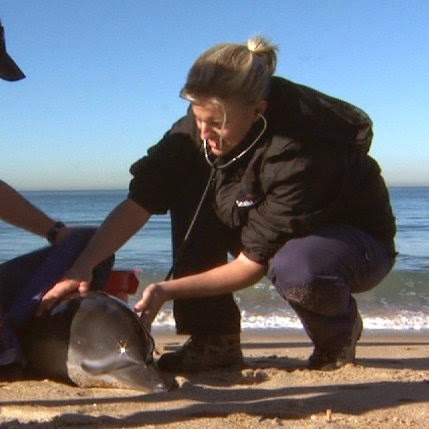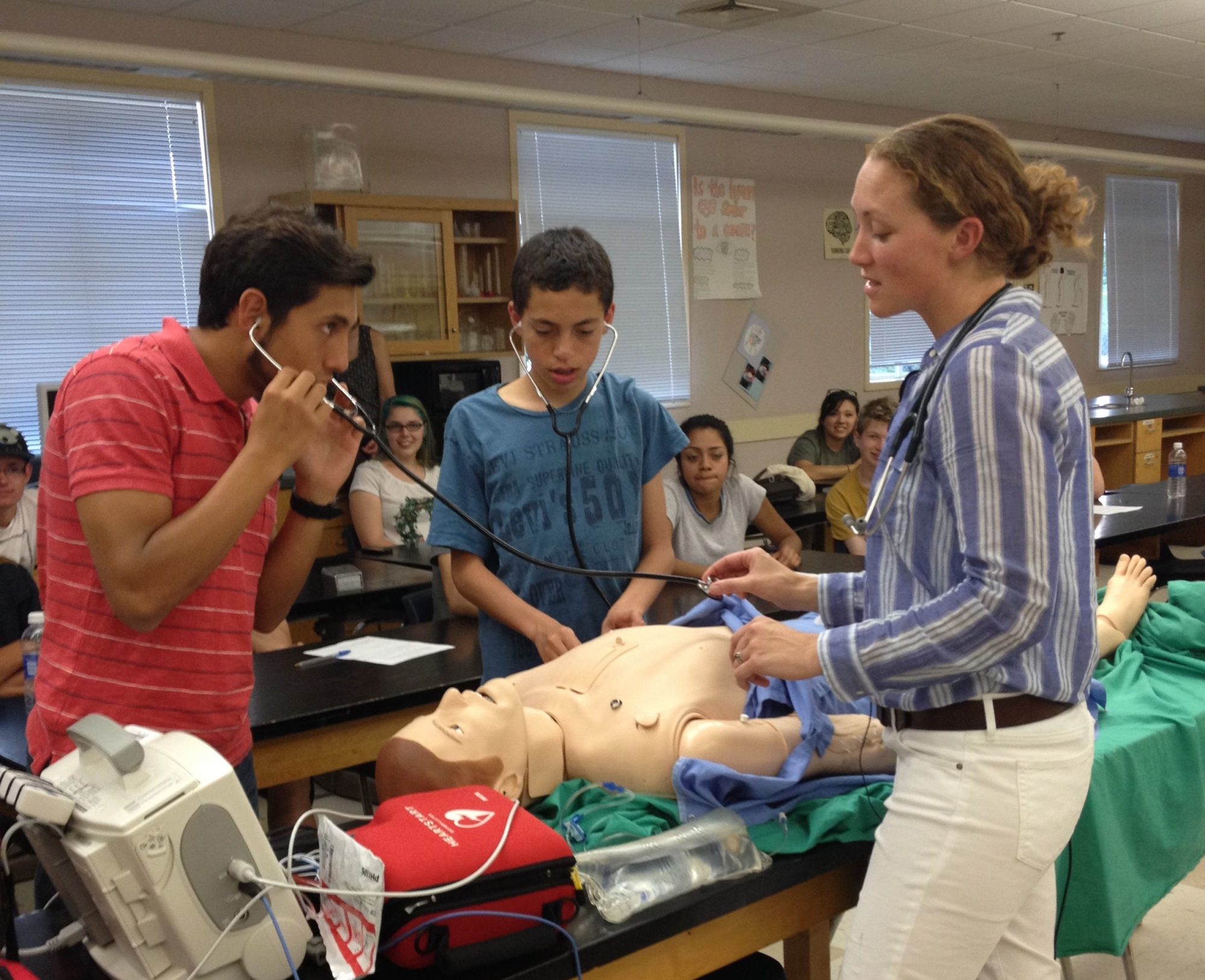by MSS Intern Isobel Wright, Tamalpais High School
From sea lions with cancer to stranded motherless seal pups, Dr. Claire Simeone knows just what to do. Dr. Simeone works as a Conservation Medicine Veterinarian at The Marine Mammal Center in Sausalito, California and at the National Marine Fisheries Service in Washington, DC. In addition to tending to sick animals, she travels the world to attend Unusual Mortality Events, international training programs, and works on the Marine Mammal Health Map. Dr. Simeone attended the University of Maryland College Park to receive her BSc in Physiology and Neurobiology, and graduated from veterinary school at Virginia Tech. Read the following interview to learn more about life at the Marine Mammal Center and working with animals.
 |
| Claire Simeone, DVM |
Could you walk me through your typical day at The Marine Mammal Center?
One of the best things about working at The Marine Mammal Center is that every day is different. Some days, you’re caring for harbor seal pups that have been separated from their mother. Another day, you’re treating California sea lions with cancer. You might be medicating elephant seals that are dying of lungworms. Some days, you’re treating all of those animals, plus caring for the two hundred additional animals that are ALSO onsite.
As a veterinarian, I usually start my day walking around the pens to check in on all of the animals on-site, and then our team starts procedures, which include blood draws, x-rays, and surgeries. If animals die, we perform post-mortem exams to determine why they died. At the same time, our volunteer crews (more than 1,000 committed people!) are preparing fish, feeding the animals, and cleaning their pens. Our night volunteer crews take care of the animals into the night, and the veterinarians and technicians are on-call 24 hours a day to make sure all of the animals receive the care they need.
What are the best and worst parts of your job?
There are so many best parts of my job. First, I’m lucky to be able to travel around the world to care for marine mammals and learn more about them. Second, I really feel that I’m making a difference with the work I’m doing – whether it’s saving a seal pup or training the next generation of marine mammal veterinarians. Third, I’m constantly learning new things – about marine mammals, their habitats, and what affects their health.
Because I do work with animals, a difficult part of the job can be seeing animals that are suffering, often because of things humans do – but it helps to know that we are doing everything we can to bring that animal back to health.
What does it feel like to rescue an animal?
Imagine getting a call from someone who was on vacation, and saw a California sea lion that had fishing line around his neck. First, you feel focused – you take down the description of the animal from the citizen, check your maps, and plan out your strategy. Your rescue volunteers have confirmed that this animal is one you’ve been watching for months, and he’s asleep on the beach. You load up the truck, and make the drive to meet your team. You feel hopeful – he’s still snoring away. Holding your breath, you sneak up slowly, and then with a leap you throw the net over his head. He roars as he jumps up and finds himself trapped. With swift action your team boards him into a carrier, and as stealthily as you came, you load him into the truck. You feel elated as you watch him resting calmly on the way home.
After a quick procedure to remove the line, it’s clear his wound will heal on its own, and he’s ready to go back to the ocean. After driving him back to the beach, you open the carrier, and he strides out into the waves and dives under the break. You feel proud that you’ve saved this animal’s life, and returned him to his ocean home.
What’s the most common injury/disease you see in marine mammals? How can we prevent this?
Unfortunately, we commonly see injuries that are due to something called human interaction – entangled in fishing line, nets, or plastic packing straps; ingesting pieces of plastic; struck by a boat; or gunshot. In 1972 the Marine Mammal Protection Act was passed, making it illegal to harass or harm a marine mammal. However, many marine mammals are still harmed in passive ways from our trash or discarded items. You can prevent these entanglements by properly disposing of plastics, and helping to keep beaches clean by picking up any trash you see. Just a few weeks ago the annual International Coastal Cleanup Day brought 54,000 volunteers to California’s coasts. They removed over 680,000 pounds of trash in one day!
What level of education and experience do you need to obtain a job like yours?
As a veterinarian, I have a bachelor’s degree, as well as a DVM – Doctor of Veterinary Medicine. However, there are many ways that you can be involved with marine mammals or ocean conservation – through a Master’s or PhD, if you’re more science-focused, or you can have a completely unrelated career, and get your fill through volunteering at a facility like TMMC. We even have a Youth Crew volunteer program for teenagers 15-18 years old (learn more at http://www.marinemammalcenter.org/Get-Involved/volunteer/youth-crew ). As far as experiences go, I would recommend doing as much as you can to get a variety of experiences, which will help you decide what is really right for you. I’ve worked with dogs and cats, horses and cattle, birds and seals, and each experience set me up for the next step in my career.
What have you learned from working with these animals?
I’ve learned that in order to conserve energy while diving, some seals can lower their heart rate to 10 beats per minute, and right before they surface, their body speeds the rate back up to 120. I’ve learned that a sea otter, if left alone, will unscrew all of the screws on a drain – that were placed with an electric drill! – with its bare paws. And I’ve learned that a harbor seal, blind from cataracts, can find fish by sensing the water movement with its vibrissae (whiskers). Each one of our patients has given me great stories with which to share the knowledge I’ve learned.
What is an Unusual Mortality Event? What is it like to attend one? Tell me about the most recent one you attended?
If a group of marine mammals are sick, they may strand on the beach near one another. Unusual Mortality Events (UMEs) are declared when the number of sick or dying animals is larger than expected in that area or time frame. A panel of experts is then called to lead a response to care for the animals, and to try to figure out why they are dying. A recent UME was close to home – in 2013, more than 1500 starving California sea lion pups washed up on southern California beaches. Thanks to the UME response team, it was determined that the reason the pups were starving was because the fish their moms were feeding on had moved farther offshore – meaning they had to go farther to forage. This caused moms to either lack the milk they needed to nurse them, or abandon their pups completely. Caring for hundreds of sea lion pups at a time is exhausting – most need to eat 3-4 times a day, and they may need treatment for vomiting, diarrhea, or pneumonia. It was thanks to hard-working rehabilitation centers, like TMMC, all along the California coast, that we were able to save so many pups.
What is the Marine Mammal Health Map? How do you contribute to it?
Think about all of the animals we’ve talked about – starving sea lions, entangled elephant seals, gunshot animals or animals with cancer. Each one of these animals provides a unique look at what is happening in the ocean at that location. All of the animals that come through TMMC have a record with all of their health information. Similarly, all of the stranding centers across the country have records on all of their animals. However, there is no centralized database to collect these data, or display them for all to see. The Marine Mammal Health Map will be that space – so that biologists, veterinarians, and members of the public will know what’s happening to marine mammals in their area. I’m working with scientists from around the country to develop the Health Map and ensure that all of our marine mammals are represented. You’ll have to come to the talk to learn more!
Watch this video below to see the process of the rescuing, rehabilitation and release of a sea lion…
Join us for “Sick Seals and Seizing Sea Lions: What Marine Mammals Can Tell Us About the Health of Our Oceans” with Claire Simeone DVM of The Marine Mammal Center, Sausalito – Wednesday, October 8th, 2014 at Marin Science Seminar



 Title: “The Pharmacy of Genes: Drug Development for Genetic Diseases” with Natalie Ciaccio Ph.D. of Biomarin
Title: “The Pharmacy of Genes: Drug Development for Genetic Diseases” with Natalie Ciaccio Ph.D. of Biomarin















